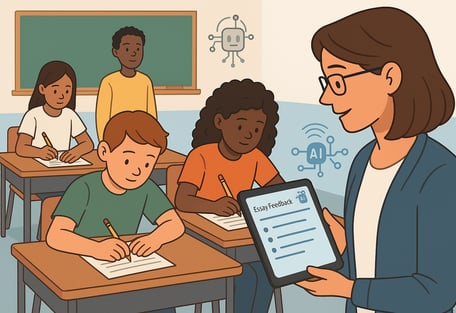An Example of How AI Can Specifically Help to Assess Writing More Effectively and Thereby Even Improve Education in General
Grading essays takes time—time many teachers don’t have. But new AI tools could help close the writing gap, especially for students who’ve long been left behind.


Writing is a critical component of any student’s education and is imperative to master to thrive in higher levels of education and in most higher-level jobs. Writing is not only a tool to convey your ideas in a digestible way but also is a way to organize your thoughts for yourself. It is important for students to start learning how to write early and often (Hall, n.d.). Over the years the U.S. Congress has seemingly pushed writing to the wayside in favor of reading and math, mandating those subjects be tested every two years while the writing tests are done much more sporadically (Wexler, 2023). Surprisingly, the last writing test administered by the NAEP, the main U.S. nationwide testing association in America, was in 2011 with the next round of testing scheduled for 2030 (Wexler, 2023). The data collected shows that only 27% of eighth–twelfth graders were graded as “Proficient,” which was seven points lower than the reading scores for the year (Wexler, 2023). This data shows a glaring need for improvement in this educational category.
One of the largest challenges instructors face in teaching writing is the time it takes to grade and give feedback for each written assignment. A teacher’s life is already consumed by many other tasks such as lesson planning, teaching, administrative work, and grading other work for the week. This problem is reportedly worse for low-income schools, as the National Center for Educational Statistics reports that teachers in low-income schools are almost 20 percent more likely than teachers in other schools to report being overburdened by routines of this nature (Baffour et al., 2023).
Providing thoughtful feedback on essays is a time-consuming task that often deters teachers from assigning more writing exercises. The Institute of Education Science’s What Works Clearinghouse recommends students spend more than 30 minutes of their school day writing (Graham et al., 2012). Yet the National Assessment of Educational Progress surveys of students show that this optimal number is reached only 25% of the time (Baffour et al., 2023). The significant effort required to offer meaningful feedback is a major barrier to increasing writing practice opportunities for students. Stanford professor Sarah Levine highlights the potential of AI in helping teachers feel more comfortable assigning and grading essays, noting that many teachers feel daunted by teaching writing due to their own insecurities about their writing skills (Chen, 2023). This writing gap is made worse for marginalized groups of Black, Hispanic, and low-income students, who scored less than 15 percent proficient, which means this demographic will fall even further behind (Baffour et al., 2023).
The issues of saving teachers time so they can focus on educating the youth, bridging the equity gap, and incentivizing assigning writing assignments can all be problems to look toward artificial intelligence to fix. The task of evaluating and commenting on essays is notably time-consuming for educators. Consequently, Ellis Page introduced the concept of computer programs capable of reviewing and providing feedback on student essays in 1966 (U.S. Department of Education, 2023). New AES and assisted writing feedback tools (AWFTs) may prove to be immensely helpful in creating solutions to helping all students become better writers (Baffour et al., 2023). A study done by researchers from The Learning Agency Lab, a nonprofit organization that seeks to improve K–16 education at cost, found that the most promising solution to save teachers time in a cost-effective way was the use of assisted writing feedback tools (AWFTs) in the classroom (Baffour et al., 2023).
While automated essay grading and feedback programs have a high upside to help teach writing, there are still current limitations and barriers to the success of these models. The main obstacles include the high costs and proprietary nature of leading AWFTs, the infancy of the algorithms, and the limited efficacy of AWFTs for students below grade level. While some of these may go away as AI in EdTech develops and matures and becomes more of a “commodity,” other considerations may not be as universally distributed, such as the efficacy of AWFTs for certain student populations. All of these opportunities and trends merit continued attention as AI and its impact on assessment evolves.
References
Baffour, P., Lopez, M., & Deane, P. (2023). The Feedback Prize: A case study in assisted writing feedback tools. The Learning Agency Lab. https://www.the-learning-agency-lab.org/publications/the-feedback-prize
Baffour, P. (2023). AI can grade a student essay as well as a human. But it cannot replace a teacher. The Hechinger Report. https://hechingerreport.org/ai-can-grade-a-student-essay-as-well-as-a-human-but-it-cannot-replace-a-teacher/
Chen, G. (2023). AI will transform teaching and learning. Let’s get it right. Brookings Institution. https://www.brookings.edu/articles/ai-will-transform-teaching-and-learning-lets-get-it-right/
Graham, S., Bollinger, A., Booth Olson, C., D’Aoust, C., MacArthur, C., McCutchen, D., & Olinghouse, N. (2012). Teaching elementary school students to be effective writers: A practice guide (NCEE 2012-4058). U.S. Department of Education, Institute of Education Sciences. https://ies.ed.gov/ncee/wwc/Docs/PracticeGuide/writing_pg_062612.pdf
Hall, S. (n.d.). Every child is a writer: Understanding the importance of writing in early childhood. Reading Rockets. https://www.readingrockets.org/articles/every-child-is-a-writer
U.S. Department of Education. (2023). Artificial intelligence and the future of teaching and learning: Insights and recommendations. Office of Educational Technology. https://tech.ed.gov/ai-future-of-teaching-and-learning/
Wexler, N. (2023). We get national reading test results every 2 years. Writing? Try 20. Education Week. https://www.edweek.org/teaching-learning/we-get-national-reading-test-results-every-2-years-writing-try-20/2023/05